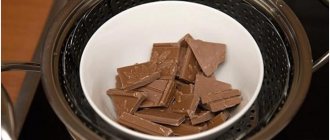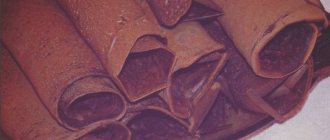Marking according to GOST
In Russia, a unified standard is established according to GOST 31721-2012.
And in accordance with its requirements, product packaging must contain the following information:
- date of manufacture;
- shelf life of chocolate;
- compound;
- storage conditions and methods.
It should be accessible to the buyer and easy to read. Clause 3 of Part 8 of the current standard states that the sales period for goods depends on the manufacturer’s technical documentation and manufacturing recipe.
If the wrapper is small, the information may be on a special insert. The shelf life of chocolates and other products made from cocoa powder, which are sold by weight, is indicated on the shipping container (boxes).
How to deliver chocolate in hot weather?
If in winter you can carry a chocolate bar in your hands, then in summer you won’t be able to do this - it will melt. The problem is so pressing that in hot countries, manufacturers have learned to make non-melting sweets.
We have prepared 3 tips if you need to deliver chocolate in hot weather:
- Thermal bag: maintains the set temperature, which will help transport the chocolate without consequences. Place a bottle of ice nearby to keep the cold longer.
- Thermos for food: the wide neck will fit a standard chocolate bar.
- Freezing: Place the chocolate and bottles of water in the freezer for at least 24 hours, before leaving, wrap the chocolate in a towel and place it in your backpack along with the ice bottles.
Thanks to our tips, the chocolate bar will not turn into a shapeless sweet mass.
Rules for storing chocolate products
To preserve the taste and characteristics of chocolate products, it is recommended to store them in their original packaging. Any remaining product should be well packaged and stored in a cool, dark place, protected from ultraviolet rays. Since chocolate products can absorb foreign odors, they should be kept separate from strong-smelling products.
Storage rules:
- air temperature – maximum +20ºC;
- humidity level – maximum 70%.
After opening the package, consume within 5 days.
Why you can store chocolate in the refrigerator, but it is not advisable
Chocolate does not react well to temperature changes, so it is not recommended to store it in the refrigerator: this can cause white deposits and condensation to appear. If the room temperature exceeds +20ºC, the product can be placed on the bottom shelf or on the refrigerator door. In this case, the shelf life of chocolate varies from 10 to 12 months, but if you place the product in the freezer, it will not lose its quality for several years.
Storage in vacuum containers
Vacuum packaging technology makes it possible to protect the product from external influences, slowing down the proliferation of pathogenic microorganisms. Vacuum-packed chocolate can be stored for 18 to 34 months in a cool, dark place.
Storage conditions for sweets
Chocolates require special storage conditions, because...
they are made using a variety of perishable ingredients. Storage conditions:
- air temperature +15…+18ºC;
- humidity level maximum 75%;
- Availability of sealed packaging.
Products must be protected from direct sunlight and sources of strong odors.
Chocolate storage temperature
The rules for optimal temperature and humidity apply to all types of chocolate. It is recommended to store sweets at a temperature of 15-21 degrees Celsius with a relative humidity of no more than 75%. It is important to keep the chocolate in a dark place where direct rays of sunlight will not reach. The sun's rays heat the chocolate and change its properties and texture. They note that if a chocolate bar sits in the sun, it will acquire a bitter taste.
If a white coating appears on the surface of the sweet product, you have not followed the rules. The white coating appears either from hypothermia or from excessive heating of the chocolate. When the product is supercooled, the sugar it contains begins to crystallize and a white precipitate appears on the surface. When the product overheats, cocoa butter begins to melt and flow through microcracks to the surface. Then, when the chocolate is placed in a cool environment, the cocoa butter crystallizes.
If the storage conditions are followed correctly, the chocolate will retain all its beneficial properties, attractive appearance, taste and aroma.
Sometimes you may notice a white coating immediately after purchasing sweets. This means that the manufacturer does not store its products correctly.
In Shokologo, products are stored according to all rules. You can learn more about the conditions and shelf life of our products in the section “Conditions and shelf life of chocolate”
How to recognize safe chocolate
High-quality chocolate is made only from natural cocoa powder (grated beans), cocoa butter, sugar, natural sweeteners (or sugar) and milk-containing ingredients. In addition, vanillin, soy lecithin and natural spices can be added to it.
There are several signs that chocolate is safe:
- when broken, the tile makes a characteristic crunch;
- in places of fracture, the surface acquires a matte tint;
- the product has a homogeneous structure;
- melts quickly in your mouth.
When buying chocolate, you need to pay attention to the composition and the presence of harmful additives.
Common Mistakes
Some people mistakenly think that products containing cocoa beans are not susceptible to external influences. For some time they can protect chocolate from spoilage, but after 1-2 years the product will begin to taste bitter and acquire a musty smell.
Tiles covered with mold should not be eaten, because... fungi and bacteria can cause stomach upset. Melted chocolate can be used to prepare liquid confectionery glaze, which is used to cover cakes, pastries, cookies, fruits, nuts and other homemade baked goods.
The pieces can be melted in a water bath and added to hot coffee. To avoid contact with water, it is better to heat chocolate in the microwave.
How long does chocolate actually last?
Although many manufacturers may hide this information, consumers are interested in how long chocolate actually lasts.
This product may not lose its quality for another 6 months after the end of the shelf life. Products with a large amount of natural cocoa beans can be stored much longer, because... beans act as natural preservatives. White chocolate has a limited shelf life because... it does not contain cocoa powder.
This also applies to products with fruit fillings, nuts and wafers.
By type
Many people are interested in what the shelf life of chocolate is and what determines the duration of its storage.
Bitter
Dark chocolate contains about 55% cocoa beans, 33% cocoa butter and 12% sugar. Products containing 100% cocoa do not contain natural sweeteners, which causes their bitter taste, so they can be stored for 1 to 2 years without loss of taste.
Dark
This product contains about 40% cocoa, 20% butter and a small amount of sugar. Depending on the technological map and manufacturing recipe, it can be stored for 6 to 18 months.
Porous
Such products have different shelf life, which depends on the content of cocoa beans in them. It can range from 6 to 12 months.
Lactic
In addition to cocoa and sugar, such products contain various dairy components, which reduce the shelf life of the product. When using stabilizers, such a product can be stored for 6-12 months.
White
This product does not contain cocoa, which is a natural preservative, so its shelf life is 1 month from the date of manufacture. To ensure that the product does not lose its quality for a long time, some manufacturers use various preservatives and stabilizing additives.
With additives
Products with various large or small fillings, such as hazelnuts, dried fruits, puffed rice and waffles, can be stored for 4 to 6 months.
With filling
Products containing dairy ingredients and perishable fillings can be stored for 2 to 6 months.
Homemade chocolate
Chocolate and other homemade desserts must be consumed within 10-14 days from the date they are made.
What periods do manufacturers set?
Each manufacturer indicates the warranty period for the sale of chocolate products on the product packaging. It depends on the composition of the product, the presence of preservatives and various additives.
| № | Trademark | Shelf life (months) |
| 1 | "Alpen Gold" | 9-12 |
| 2 | “Milka” | Up to 12 |
| 3 | “Alenka” | 6-12 |
| 4 | “Babaevsky” | Up to 12 |
| 5 | "Kinder" | 9-12 |
| 6 | "Russia" | 6-12 |
| 7 | "Nestlé" | 6-12 |
| 8 | “Ritter sport” | Up to 12 |
| 9 | "Snickers" | Up to 7 |
| 10 | “Twix” | Up to 7 |
| 11 | “Dove” | 7-12 |
| 12 | "Inspiration" | Up to 12 |
| 13 | "Mars" | Up to 9 |
| 14 | Marabou | 9-12 |
| 15 | Lindt | 12-18 |
| 16 | "Belgian" | Bitter – up to 24, milk – up to 12 |
| 17 | “Korkunov” | Bitter up to 12, milk – from 9 to 12 |
How long can a handmade product be stored?
It is recommended to store such chocolate products in a cool, dark place for no more than a month from the date of manufacture. The shelf life of chocolates with various fillings is no more than 14 days. After this time, dessert may cause food poisoning.
Where and how to properly store chocolate
You should find out why you cannot store chocolate in the refrigerator. Tiles are afraid not so much of cold as of temperature fluctuations. The more often this occurs, the greater the difference in performance, the worse the product. As a result, the tile turns white. As for the correct temperature regime, it should be like this:
- it is better to store sweets at +17...+20 degrees, it is worth considering the humidity, it should not exceed 70%;
- an indicator equal to +30℃ is critical for the delicacy; it will begin to melt, melt and lose its appearance.
The best temperature to store the product without loss of quality is considered to be +18 degrees. A deviation of 3 degrees in one direction or another is acceptable. In the refrigerator the indicator is much lower, from +3 to +6 degrees. In such conditions, water freezes out. As a result, sucrose crystals appear on the tile. The product becomes hard and tastes bland.
Important! Where to store chocolate - the preferred place is a closed cabinet, where moisture and sunlight do not penetrate.
How to determine the expiration date of chocolates and what it depends on
The storage time of chocolates is determined by the composition of the filling, i.e. the most perishable components of the product.
By weight
When buying loose candies, you must ask the seller for a product quality certificate and other documentation confirming that the batch number on the packaging corresponds to the number indicated in the submitted document.
From top manufacturers
Shelf life table for sweets from different manufacturers.
| № | Brand | Shelf life (months) |
| 1 | “Mouth front” | 6 |
| 2 | “Ferrero Rocher” | 9 |
| 3 | "Alpen Gold" | 9 |
| 4 | "Mercy" | 10 |
| 5 | "Nestlé" | 9 |
| 6 | "Snickers" | 7 |
| 7 | "Mars" | 7 |
| 8 | “Bounty” | 7 |
| 9 | “Babaevskie” | 5 |
| 10 | "Little Red Riding Hood" | 9 |
| 11 | “My fire” | 9 |
Signs of the end of the shelf life of goodies
You can identify a product with an expiring shelf life using several criteria:
- the surface is covered with small sugar crystals;
- a matte light coating appeared on the tiles due to melted cocoa butter;
- uneven color of chocolate at the break;
- the taste becomes a little bitter and unpleasant.
Why does chocolate turn gray?
A whitish coating, called Oswald ripening, is a normal condition for products nearing the end of their shelf life. This process can be accelerated if product storage rules are violated as a result of crystallization of melted cocoa butter or sugar.
Is plaque on chocolate dangerous?
Light plaque does not harm the human body, because... is not a mold. Its appearance is due to the chemical reaction of product components such as cocoa butter or sugar. Despite this, it significantly affects the taste of chocolate, giving it bitterness.
How to tell if candy is spoiled
In order to determine the quality of sweets, you need to perform a number of actions:
- open the package or unwrap the wrapper and evaluate their appearance;
- products must have a uniform brown color without a light coating, which indicates a violation of storage rules;
- if there are small holes on the sweets, this indicates that the products are contaminated with insect larvae;
- There is mold on spoiled products;
- expired candies lose moisture, become deformed and decrease in size;
- an expired product acquires a bitter or sour taste.
Chocolate storage
In this article, you learned that chocolate must be stored at a temperature of 15-21 degrees and at an air humidity of no higher than 75%. If the conditions are not met, the chocolate will deteriorate faster and a white coating may appear on the bar. The shelf life of dark chocolate is 18 months, milk and ruby chocolate is 12 months, white chocolate is 6 months. The shelf life is reduced if the chocolate has filling or additives.
Use these recommendations and you will get the maximum taste and benefits from such a pleasant dessert as chocolate.
What to do with chocolate after its expiration date
If the product is slightly expired, a light matte coating has appeared on it, but it has no visible damage or bitterness, it can be heat treated for further consumption. You can make various confectionery products from this chocolate.
Is it possible to return expired sweets to the retail chain?
If a consumer discovers that the purchased chocolate has expired, he can return it to the retail chain by following a number of steps:
- present to the store a receipt indicating the date of purchase of the goods;
- in the absence of a receipt, it is necessary to find witnesses who will confirm the purchase of the goods in this store and provide packaging elements;
- if you refuse to accept the goods and pay monetary compensation, you should leave the claim in the book of complaints and suggestions;
- file a complaint with the Center for Hygiene and Epidemiology or a consumer protection organization.
Is it possible to eat expired chocolate and what will happen to the consumer?
Spoiled chocolate may contain microbes, fungi and bacteria that are dangerous to the human body and can cause food poisoning. In addition, oxidized fats contribute to the development and growth of tumors. If a person consumes a small amount of expired chocolate, this will not lead to cancer.
First aid for poisoning
First you need to drink a lot of water. Then you need to rinse the stomach and cleanse the intestines of the remnants of spoiled chocolate. After this, take one of the adsorbent drugs (Polysorb, Atoxil or Enterosgel), as well as an enzymatic agent. If your health worsens, you should consult a doctor.
Consequences of poisoning
Food poisoning can cause an intestinal infection, which is accompanied by vomiting, diarrhea, severe pain in the gastrointestinal tract, liver and pancreas. In addition, chills and fever appear with an increase in temperature.
During an allergic reaction, skin rashes appear on the body in the form of small or large red spots. Severe itching, runny nose, watery eyes appear, and asthma attacks may occur. Severe poisoning can cause convulsions and loss of consciousness.
Feeling worse may be a consequence of eating too much chocolate.











